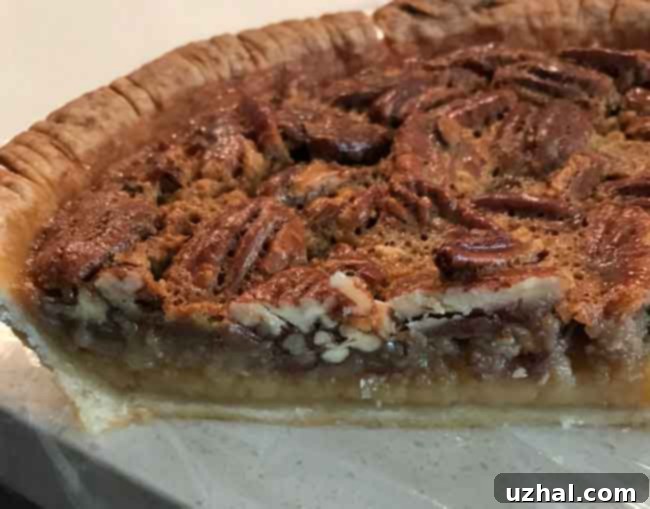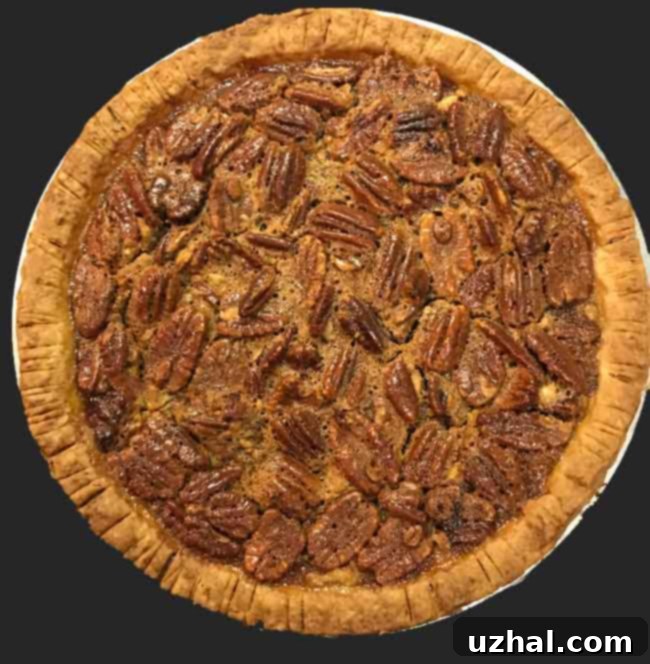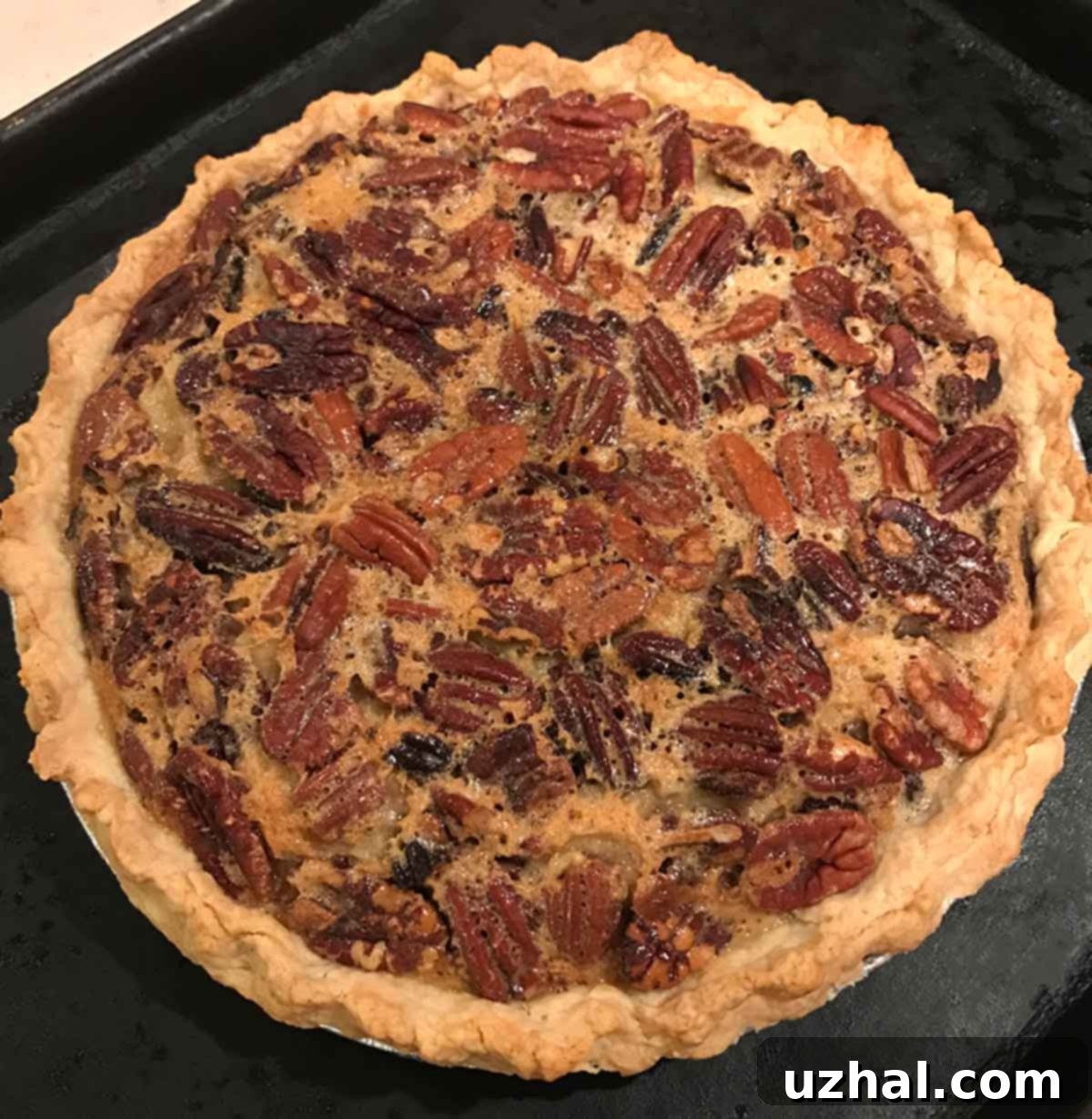The Ultimate Less Sweet Sour Cream Pecan Pie: A Perfectly Balanced Dessert Recipe
For many, a classic pecan pie is the quintessential Southern dessert, a symbol of warmth and tradition, especially during holidays. However, its signature sweetness can sometimes be overwhelming. If you adore the rich, nutty flavor of pecan pie but often find yourself wishing it were a little less sugary, then you’ve found your new favorite recipe! This exceptional less sweet pecan pie, crafted with the clever addition of sour cream, offers a delightful departure from the norm. The sour cream doesn’t just cut down on the sweetness; it also introduces a subtle tang and a wonderfully balanced flavor profile that makes this pie truly unique. Moreover, this recipe intentionally uses less sugar than most traditional versions, contributing further to its perfectly understated sweetness.
This isn’t just a slightly modified recipe; it’s a reimagining of a beloved classic. The result is a pie that strikes a harmonious balance, allowing the natural, earthy notes of the pecans to shine through without being drowned out by excessive sugar. It’s a dessert that invites you to savor each bite, appreciate the nuances of its flavors, and perhaps even discover a new favorite holiday tradition.

One of the distinctive characteristics of this sour cream pecan pie is its texture. It’s not runny by any means, but the filling possesses a softer, less rigid quality compared to some ultra-firm pecan pies. This means it yields gently when you slice into it, creating a more tender and luxurious mouthfeel. While it might “squish down a little” when cut, this isn’t a flaw; it’s a desirable trait that contributes to its overall appeal. If your preference leans towards an exceptionally stiff pecan pie, this particular version might offer a different experience, but one that is equally, if not more, delicious. This softer texture allows the filling to melt in your mouth, offering a truly indulgent experience. Below is a detailed texture shot of the pie, freshly removed from the refrigerator, showcasing its inviting consistency.

Furthermore, this pie holds up beautifully to freezing, an excellent option for make-ahead convenience. Interestingly, freezing tends to smooth out the filling even further, creating an almost silken consistency once thawed and brought back to serving temperature. This makes it a fantastic choice for planning ahead for special occasions or simply ensuring you always have a delicious dessert on hand. Below, you can see a shot of the pie after it has been frozen, thawed, and then expertly sliced, demonstrating its versatility and consistent quality.

Whether you serve it chilled, at room temperature, or after freezing, this less sweet pecan pie promises a memorable dessert experience. Its nuanced flavors and tender texture are sure to impress even the most discerning palates. To give this incredible pie a try, here are some essential notes and tips on the ingredients and methods used to achieve perfection.

Essential Tips for Baking Your Less Sweet Pecan Pie
Baking a successful pecan pie often comes down to the details. Here’s an in-depth look at what works best for this specific recipe, from your choice of pie pan to the individual ingredients that make up its irresistible filling.
Choosing the Right Pie Pan
The type of pie pan you use can subtly influence the baking process and the final texture of your pie. For this less sweet pecan pie recipe, shallower pie dishes or even the common disposable aluminum pie plates tend to yield the best results. These pans often allow for more even heat distribution and a slightly crisper bottom crust without overbrowning the top. While I haven’t extensively tested this recipe in a glass dish, traditional glass pie plates are generally reliable and should work perfectly fine, though you might need to keep a closer eye on baking times and crust browning to prevent any over-baking. Regardless of your choice, ensure it’s a standard 9-inch pie pan to accommodate the recipe’s proportions.
The Secret to a Flaky Sour Cream Pie Crust
While a store-bought frozen or refrigerated pie crust offers convenience, embracing a homemade sour cream crust for this particular pecan pie elevates the entire experience. This bespoke crust is designed to perfectly complement the filling, offering a delicate flakiness and a subtle richness that enhances the pie’s overall flavor. The sour cream in the crust dough contributes to its tenderness and provides a slight tang that harmonizes beautifully with the filling. I’ve found that using a food processor makes quick work of preparing this crust, yielding consistent results every time. It’s a game-changer compared to making it by hand, ensuring the butter remains cold and evenly distributed, which is key to a truly flaky crust. Trust me, the extra effort for this crust is well worth it!
To Blind Bake or Not to Blind Bake? Understanding Partial Baking for Pecan Pie Crusts
Blind baking, or partially baking, a pie crust is a common practice for many custardy fillings to prevent a soggy bottom. For traditional pecan pies, I typically skip this step. However, for this less sweet pecan pie recipe, I conducted tests with both a partially baked crust and an unbaked crust to determine the optimal approach. Partially baking the crust did result in a slightly stiffer, more robust bottom, which some bakers prefer. The drawback, however, was that the crust edges browned a bit too rapidly, requiring careful shielding during the main bake. When I made the pie again without partially baking the crust, the results were entirely satisfactory. The crust baked up beautifully and held the filling well, though shielding the edges during the later stages of baking was still necessary to prevent over-browning. Ultimately, for this recipe, I recommend skipping the partial bake for simplicity and excellent results, focusing instead on covering the edges with foil if they start to darken too quickly, typically during the last 15-20 minutes of baking.
Crafting the Perfect Pecan Pie Filling
The heart of this less sweet pecan pie lies in its perfectly balanced filling. Each ingredient plays a crucial role in achieving the desired flavor and texture:
- Toasted Pecans: I highly recommend using pecan halves for their superior texture and visual appeal in the finished pie. Simply ‘dumping’ them in without chopping helps maintain their substantial bite. Toasting the pecans beforehand is a non-negotiable step; it profoundly enhances their flavor, bringing out a deeper nuttiness and a more aromatic quality that elevates the entire pie. As soon as your oven preheats, spread the pecan halves on a baking sheet and toast them for a quick 6 to 8 minutes, or until they become fragrant. You can also toast them at a lower heat or on the stovetop if preferred. Remember to use *untoasted* pecans if you plan to arrange a decorative layer on top, as they will brown sufficiently during the main baking process.
- Eggs: Use large eggs and ensure they are at room temperature. This simple step makes a significant difference, allowing them to blend much more smoothly and evenly with the sour cream and butter, resulting in a homogenous filling free of lumps. Eggs are vital for binding the filling and providing structure.
- Sugar: A mere ½ cup of granulated sugar is all that’s needed for this recipe. This drastically reduced amount, combined with the sour cream, is what truly makes this a “less sweet” pecan pie, allowing the other flavors to shine without being overshadowed.
- Corn Syrup: Dark corn syrup is my preference as it imparts a richer, more complex flavor and a slightly deeper color to the filling. However, light corn syrup can be used as a perfectly acceptable substitute without compromising the pie’s structure or glossy finish. Corn syrup is essential for preventing sugar crystallization and achieving that classic gooey, yet set, pecan pie texture.
- Sour Cream: This is the star ingredient that sets this recipe apart. Sour cream works magic in several ways: it significantly curbs the sweetness, preventing the pie from becoming cloying; it lends a subtle tang that balances the richness; and it contributes to the filling’s tender, softer texture. It’s critical that the sour cream is at room temperature to ensure it incorporates smoothly into the other ingredients.
- Butter: Melted butter adds a crucial layer of richness and smoothness to the filling, complementing the sour cream’s acidity. It also enhances the overall flavor profile, providing that comforting, classic dessert taste.
- Salt & Vanilla: Don’t underestimate these two. A small amount of salt acts as a flavor enhancer, expertly counteracting and balancing the sweetness. Vanilla extract, on the other hand, adds a depth of aromatic flavor that is indispensable in any sweet baked good, rounding out all the notes beautifully.
Alternative Pecan Pie Options and Related Baking Delights
If, after reading about the unique qualities of this sour cream pecan pie, you decide it might not be quite what you’re looking for, or if you’re simply curious about other less sweet alternatives, I’ve got you covered. A very similar and equally delightful recipe is Mom’s Pecan Pie, which also features a reduced sweetness level for those who prefer a more balanced dessert.
Beyond pecan pies, if you’re exploring other comforting and delicious baking projects, here are some related links to inspire your culinary adventures. These recipes offer a range of flavors and textures, from hearty muffins to decadent cookies and other pecan-infused treats:
- Cooked Oatmeal Muffins: A wholesome and satisfying breakfast or snack option.
- Sour Cream Chocolate Cookies: Discover how sour cream can add moisture and a slight tang to rich chocolate cookies.
- The Best Pecan Pie Yet: For those who love a classic, traditional pecan pie experience.
- Pecan Caramel Corn with Pretzels: A delightful sweet and salty snack, perfect for sharing.
- Small Batch Chocolate Pecan Pie Bars: A convenient and equally delicious way to enjoy the flavors of pecan pie in bar form.
Recipe: Less Sweet Sour Cream Pecan Pie

Less Sweet Pecan Pie
Anna
Pin Recipe
Ingredients
Sour Cream Pie Crust
- 1 cup all-purpose flour (140 grams)
- 2 teaspoons granulated sugar
- ¼ teaspoon salt
- 6 tablespoons cold unsalted butter (85 grams), cut into small pieces
- ¼ cup full-fat sour cream (60 grams)
Pecan Pie Filling
- 1 ⅔ cups pecan halves (toasted)
- 3 large eggs (at room temperature)
- ½ cup granulated sugar
- 1 cup dark corn syrup
- ¼ cup full-fat sour cream (at room temperature)
- 2 tablespoons unsalted butter (melted)
- ¼ teaspoon salt
- 1 ¾ teaspoons pure vanilla extract
Instructions
-
Prepare the Sour Cream Pie Crust: In the bowl of a food processor, pulse the flour, granulated sugar, and salt together a few times until well combined. Add the cold butter chunks and pulse in short bursts until the mixture resembles coarse crumbs with some pea-sized pieces of butter remaining. Add the sour cream and pulse until the mixture is just combined and appears moist. It will still look crumbly, but should hold together when squeezed.
-
Turn the crumbly mixture out onto a clean pastry mat or lightly floured surface. Gently knead the dough together with your hands for a minute or two until it forms a cohesive, firm mass. Use a bench scraper to gather it up, then flatten it into a disk, wrap it tightly in plastic wrap, and chill it in the refrigerator for at least 1 hour (or up to 2 days). This chilling period is crucial as it helps relax the gluten, making the dough easier to roll, and prevents shrinkage during baking.
-
Roll the Crust: Remove the chilled dough from the refrigerator and let it stand at room temperature for about 10 minutes to soften slightly, making it easier to roll. On a lightly floured surface, roll the dough into a 12-inch circle, large enough to generously cover a 9-inch pie pan. Carefully transfer the rolled dough to your 9-inch pie pan, gently pressing it into the bottom and sides. Trim and crimp the edges as desired. Place the lined pie pan in the freezer while you prepare the filling. This further helps to firm up the butter and prevent shrinkage.
-
Toast the Pecans: Preheat your oven to 400°F (200°C). Spread the pecan halves in a single layer on a rimmed baking sheet. Toast them in the preheated oven for approximately 6-8 minutes, or until they are fragrant and lightly browned. Be careful not to burn them. Remove from the oven and set aside to cool slightly.
-
Prepare the Pecan Pie Filling: In a large mixing bowl, whisk together the room temperature eggs, ½ cup granulated sugar, and dark corn syrup until smooth. Then, whisk in the room temperature sour cream, melted butter, pure vanilla extract, and ¼ teaspoon salt until the mixture is completely homogenous. Gently fold in the toasted pecan halves, ensuring they are evenly distributed throughout the filling.
-
Assemble and Bake: Retrieve the chilled pie shell from the freezer. Carefully pour the prepared pecan pie filling into the crust-lined pan. Place the pie on a baking sheet (this makes it easier to transfer and catches any potential drips).
-
Bake at 400°F (200°C) for an initial 10 minutes. This high heat helps to set the bottom crust. After 10 minutes, reduce the oven temperature to 350°F (175°C) and continue to bake for an additional 35-45 minutes, or until the filling appears set around the edges with a slight jiggle in the center. To prevent the crust edges from browning too quickly, loosely cover the entire pie with a sheet of aluminum foil during the last 15-20 minutes of baking.
-
Cool and Serve: Once baked, remove the pie from the oven and let it cool completely on a wire rack at room temperature. For the best texture and stability, it is highly recommended to then chill the pie in the refrigerator for at least 3-4 hours (or overnight) before slicing and serving. This allows the filling to fully set. While you can skip the chilling for a softer pie, the structure will be less firm. Bring the pie back to room temperature before serving for optimal flavor. Alternatively, this pie freezes beautifully for longer storage; simply thaw it completely in the refrigerator and bring to room temperature before serving. Enjoy your perfectly balanced, less sweet pecan pie!
